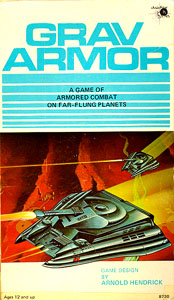


Grav Armor's game gem is the terrain chart. There is a different chart for the various planetary type, from murky Venus type to airless moon. The games are all played on the same geomorphic map, but the terrain chart specified for the scenario utterly changes the meaning of each type of colored hex.
The different terrain effects have such drastic effect on gameplay that it is almost an entirely different game. It is truly startling how sensitive gameplay is to this one small factor.
On a Venus world (Scenario Four, class "H" world), the tanks move freely, but blindly. Effective combat range is only a couple of hexes. And even then it is difficult to successfully damage one's target.
An airless frozen ice world (Scenario Three, class "F" world) is totally different. Tanks move slowly through the broken terrain of the mountains. Venturing out onto the plains is virtual suicide. Every single hostile tank on the map can see you even if they are on the far side of the map, and you will quickly be mission-killed in the ensuing hail of weapons-fire.
The Details:
Each terrain type has a combat value. This is determined by the terrain effects chart in use for the current scenario (i.e., it depends upon what kind of planet the battle is taking place on).
First, a target can only be fired upon if it is detected. To determine if tank Alfa can see target tank Zebra, draw an imaginary line between, and total the combat values of all hexes along the line. As is standard, don't count the firer's hex but do count the target's hex. If the total value is larger than tank Alfa's EW value, tank Alfa cannot detect tank Zebra. Naturally on murky Venus, all terrain types have high combat values. Tanks there wear black glasses and use long white canes. Meanwhile, on other planet types, the plains have a combat value of zero. This means infinite range.
Assuming tank Alfa can detect tank Zebra, Alfa's owner rolls on the Combat
Results Table to see if they hit. The column used on the table depends on
a differential between the firer's attack value and the target's defense
value. But there are many other factors that modify the differential. Of
course, one of them is the combat value of the hex the target is sitting
in.
Earth-like planet (class "T" world)
| hex color |
combat value |
description |
| yellow, orange |
0 |
plains, farmland |
| blue |
1 |
lakes, seas |
| green |
2 |
forests |
| brown |
2 |
mountains |
| city marker |
3 |
city |
Brightside Mercury (class "M" world)
| hex color |
combat value |
description |
| yellow, blue |
0 |
solid plains |
| orange |
1 |
hot plains |
| red-brown lines |
2 |
liquid metal rivers |
| brown |
2 |
cliffs, mountains |
| green |
3 |
volcanic mountains |
Frozen iceworld / gas giant's moon (class "F" world)
| hex color |
combat value |
description |
| yellow, blue |
0 |
ice plains |
| orange |
0 |
rock plains |
| red-brown |
0 detect, 2 def |
deep chasm |
| green |
1 |
icefall, talus |
| brown |
2 |
mountains |
Venus type, high pressure hothouse (class "H" world)
| hex color |
combat value |
description |
| yellow, blue, orange |
1 |
plains |
| green, red-brown line |
2 |
rough, broken plains |
| brown |
3 |
mountains |
Mars type / dead world with little or no atmosphere (class "D" world)
| hex color |
combat value |
description |
| yellow |
0 |
old crater plains |
| blue |
1 |
ice seas |
| orange |
1 |
broken rubble plain |
| red-brown lines |
0 detect, 2 def |
canyons |
| green |
1 |
low peaks, valleys |
| brown |
2 |
high peaks, chasms |
| city marker |
3 |
city |